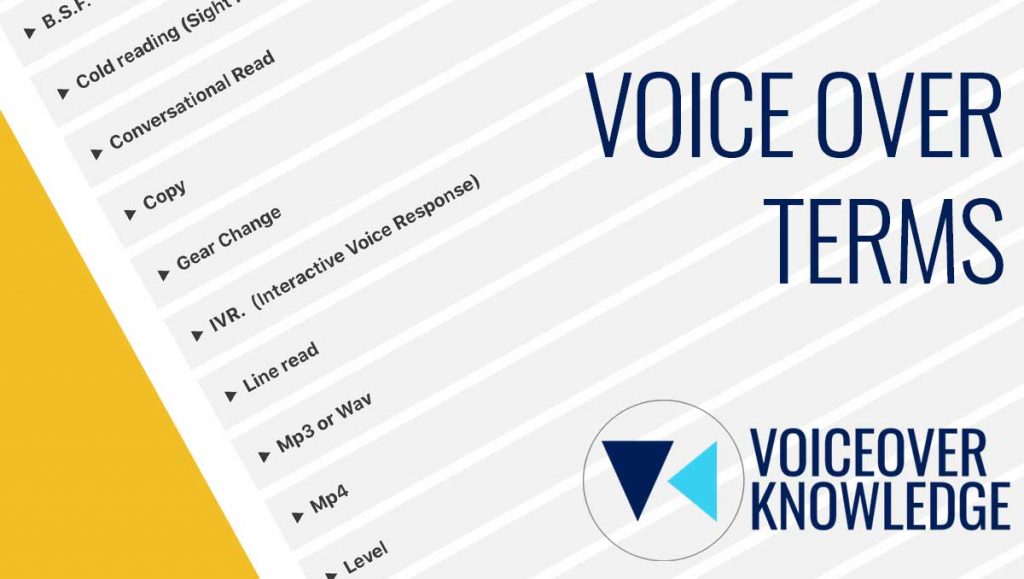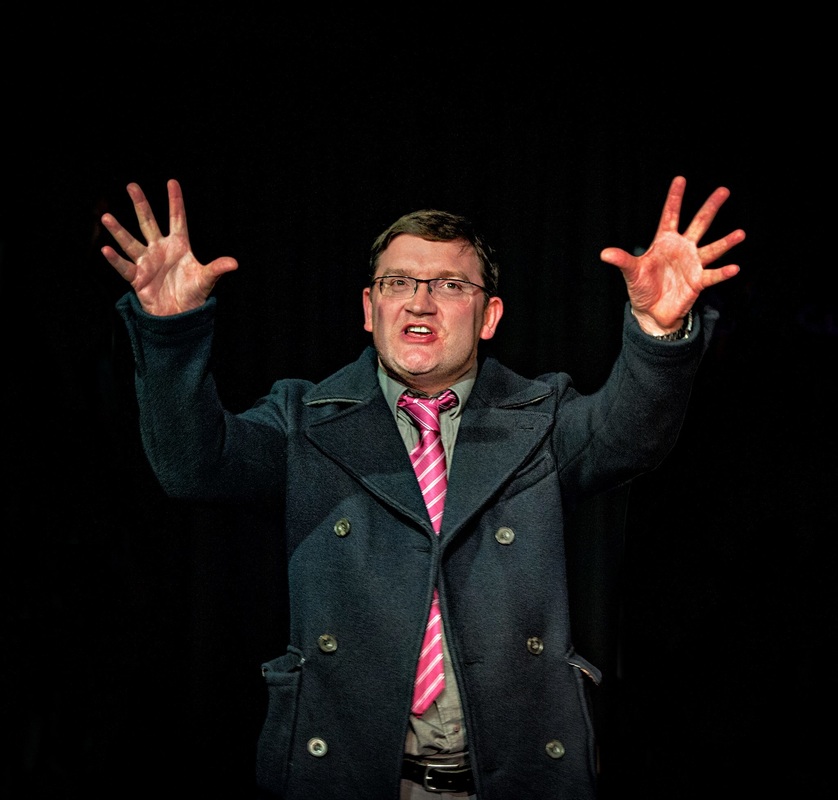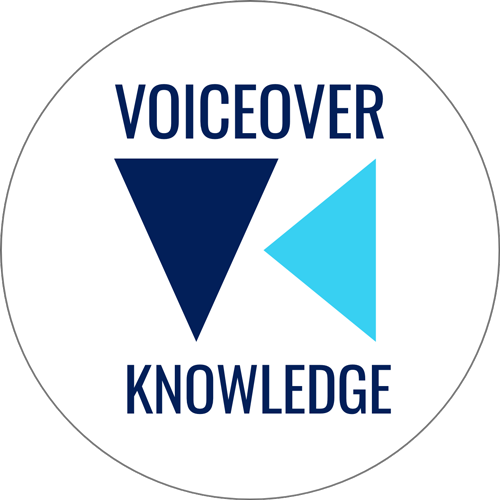
Sometimes, understanding voice over terminology can be like speaking another language. But you don’t want to ask someone to explain what they mean by the term they’ve just used, because it’ll show you as a newbie.
No problem. Here’s a starter for getting fluent in the language of voice-over. There are many terms that mean nothing to outsiders, but everything to professionals.
Next time you’re in the studio, you’ll be in the loop when working with directors, engineers and clients.
ADR
(Automatic Dialogue Replacement or Additional dialogue recording).
In film this is quite common to pick up lines that were spoiled in the original filming.
Imagine a film crew in London shooting a pivotal scene in a drama, and later it becomes apparent that a light aircraft was flying overhead and can be heard in the recording. The actor will often attend an ADR session to recreate dialogue. As a viewer, you’d never notice.
Announcer or Announcery
Originally an American term, although it has crossed the Atlantic. Going back decades (50s-80s) in US radio, there was a kind of patriarchal delivery adopted by the (almost exclusively) male presenters.
They were called “Radio Announcers”. They would holler and shout at the listener. Emphasis on ‘at’. Not ‘to’. It’s a style that is still around, but firmly rejected by many in advertising, apart from maybe parody. Today people are looking for connection, not patronisation.
If you’ve ever read Patsy Rodenburg’s book, “Presence“, it’s what she would describe as “Third Circle Energy – The Circle of Bluff and Force”. (See the opposite at ‘Conversational read’).
Beat
This is a musical term used in voice over referring to a momentary pause. You may say a word, and then leave a ‘beat’. It can be used for emphasis or another reason.
This may be confusing as the term ‘beat’ is also used in acting to mean a unit of action within a scene. (The meaning in this use is probably closer to what I call ‘Gear Change’ further down this list)
Bed
In broadcast and production, a ‘bed’ is a piece of music designed for talking over. Typically, an instrumental track and possibly custom production music. For example, if you’re in a studio about to voice a commercial… the studio engineer might ask if you want to “hear the bed?” because its pace and style might influence your delivery.
B.S.F.
Basic Studio Fee (or sometimes Basic Session Fee). For voice over artists, this is the hourly fee for being present to record in a studio. For clarity, this is not a fee to hire a studio. It also doesn’t mean you have any rights to use the audio from the session. Most uses will require licensing as appropriate
Cans
Headphones.
Cold reading (Sight reading)
This is when a voice over artist or an actor performs a script on first sight, without any rehearsal or practice of it. In acting terminology, this might be used as a form of ‘discovery’ where two actors cold read to see where it goes. Part of the process of learning. Sometimes it’s also call a ‘sight-read’.
Conversational Read
This is the current trend that is considered to be the opposite of an “announcery” read. If you think of an announcer as telling you what to do, a conversational read is more your mate down the pub. I like to think of it in terms of ‘status’. If you’ve ever done improv, you’ll have considered ‘status’ as a way to understand the relationship between two parties. In a conversation read, it’s very much a peer-to-peer status.
Copy
It’s the text of the script. Think ‘copywriter’. They write copy. You read it. You might have a script in your hand and be looking at the ‘copy’.
Dry Read
“Dry” is an industry word meaning “with no music”. If you’re asked for a dry read, then that person is looking for just a recording of your voice, without any additional music or elements.
Gear Change
Maybe this is just my own phrase! As an actor in a scene it’s the moment where you figuratively “turn a corner” and the mood or direction changes. Since a lot of voice over work presents a ‘problem’ and then a ‘solution’, I often find there is a gear change at the point where you transition from one to the other. Visually it’s raining, then suddenly the sun comes out. You get the idea.
Inflection
This is a change in the modulation of pitch or tone.
Done well it can draw attention to an important word or thought.
It can be done badly when someone artificially inflects randomly because they believe it makes what they are saying sound more interesting. Their tone just goes up and down, with rhyme, but no reason… so they sound a little like Scooby Doo!
IVR
Interactive Voice Response.
This is a genre of voice over also referred to as “On-Hold”. It’s when you call a number, and a nice pleasant voice over artist speaks to you, asking you to press 1 for reception or 2 for accounts.
Level
This is the level of an audio signal in professional recording. Sometimes referred to as “gain”.
Level is measured with a PPM (peak programme meter). If you see a picture or footage of a recording studio, you’ll always see the needles moving on the dial.
This shouldn’t be confused with volume. You can turn up the volume in your headphones, but you are not turning up the level. For instance, if something has a level that is too high, it will distort. You will hear the distortion. Turning down the volume doesn’t make the distortion go away. Level is fixed in the recording. Volume is the loudness you listen to it at.
For a voice over artist, level is important, because it’s relative to other noise. Even in a silent studio there will be a ‘noise floor’, where you start to hear hiss and hum. If your level is too low, this noise will be louder. If your level is too high, you will have distortion.
Line read
(Pronounced ‘reed’).
Some voice over artists don’t like these, because it can be considered as interfering with their “art, darling”. Sometimes, when studio time is pressing and you’re on the 12th take, you just need someone to demonstrate how they want the line to be read (this time pronounced ‘red’). In this situation, they read (reed) the line as they want you to say it. They are giving you a ‘line read‘.
From an actor’s point of view, the tone and rhythm should come from the intention and other preparation work you have done, but sometimes the client or the director just have a ‘sound in their head’ that they want to achieve.
Mono
Also sometimes known as ‘monaural’ or ‘monophonic’. Most voiceover is generally recorded in mono because generally microphones record in mono. What does that mean? Well, the audio is coming from one source, so it is only recorded in that way.
“Stereo” records two sources and by placing the emphasis one way or another you can create ‘space’ between the different elements. This might be perfect for music, because your want the guitar to sound apart from the keyboards, but it’s less of an issue with voice, unless it is part of a mix with other sources.
An important note for voice artists: If you record in stereo, but with a mono microphone, you’ll likely end up with a ‘one-legged’ recording, where the voice is only heard on one channel. Generally, voice-over artists record in mono.
Mp3 or Wav
These are audio file types. The audio equivalent of a ‘.doc’ or ‘.xls’. A ‘wav’ file, also known as a ‘wave file’ is named after its file extension. The audio file will have a .wav file extension. Often a wav file can be 10 times the size of an mp3 file. Mp3 files are smaller because there is some compression in the saving of the file. This is also why it will be an inferior quality to a wav.
Where quality is important, you will normally deal with .wav files. Sometimes demos and approval copies are sent as an mp3 because the file size is much smaller and easier to handle and send via E-Mail.
Some sectors often work with mp3 files. I often see them in IVR on-hold and some e-learning providers.
Mp4
This a video file format used frequently in video production. Named after its .mp4 file extension.
It’s worth noting that for voiceovers working in up to date versions of Adobe Audition, they can load mp4 files into their timeline.
Noise Floor
A noise floor is the level of noise created by your studio when ‘silent’. So, set your microphone to the correct level for peaking when speaking, and then fall silent. You’ll find that your studio still creates noise. A level of hiss and hum that can be heard or at least measured in your recording. A target would be at least -60db. Equipment, cables and even microphones can generate noise.
One-legged
A term used by broadcast folk in particular. Generally, it means that the audio is only on one channel when they were expecting it on two. For example, you’re listening to a stereo recording, but the sound is only on one channel, or you’re hearing it through one speaker, you might call it “one-legged”. Not to be confused with mono, where there would only be one channel in the first place.
Pick-up
This is a re-take of a specific part of the script. You ‘pick-up’ from a particular point and read a short extract. A director might ask for a pick-up in a live session. Equally where you work remotely with clients on content, they may send a list of ‘pick-ups’ to be done after the fact.
Popping
This is a sound captured when recording a voice with strong “plosives”. Often thought of as just the letter “P”, it is also possible to pop on a “B”.
When you say a plosive, you momentarily create a block and then a burst of air with your mouth. This burst of air hits the capsule of the microphone and creates a noise in the recording.
Modern editing software can often remove it, unless really bad, but not creating them in the first place is the true goal.
Processing
This is an important one for direct clients who are incorporating the voice into their own productions. Processing is when a voice over recording undergoes a series of treatments to enhance or ‘sweeten’ the sound.
Typically, it will be cleaned up with a nice tidy edit. Sometimes, the breaths will be removed (de-breathed), depending on the content. It may be EQ’ed (equalised) and compressed (Where the dynamic range is squeezed to make it sound fuller).
I would advise always being clear with your requirements here. Most experienced producers want absolutely ‘raw’ audio, because they are experts at production, and work with voice overs with different levels of production experience. This means for many, ‘raw’ is a default option.
Years ago, I learned the hard way, dealing with an end client, who took my ‘raw’ recording and dropped it into a video with absolutely no additional processing. The end result sounded flat.
Some kind of processing is normal. The question is do you expect the voice over artist to do it, or are you producing the content yourself with processing. This is a question of taste and control.
Punch and Roll
Punch and roll is a recording technique used by some voice over artists. It is particularly common in long-form recording, and especially Audio Books.
I’m not a user of Punch and Roll yet, as it’s only recently come to Adobe Audition, so I’ll leave the technical explanations to others. It’s the process triggered by the voiceover when they make a mistake. The software then goes back and plays an earlier point where you then step in with a new take.
It can significantly shorten editing time because you remove mistakes as you go.
Punch in
In studio recording, this is where you might re-record a small part of the script and cut it into the original audio, replacing what was there before.
This tends to be a manual process, where an engineer might ask for a ‘pick-up’ on a certain line, because they are going to punch in at that point. (See also Punch and roll).
Read
A read (pronounced: reed) is another way of saying a ‘take’ or referring to it. Example: “That was a great read”.
Session (Voice Over Session or Directed Session).
A Voice Over Session is an agreed period of time in the studio to record work. Typically it is booked by the hour, where a voice over artist will charge a “B.S.F.”
It can be conducted ‘Remotely‘ with a connection between the voice over’s studio and the production studio. It can also be conducted, “In-person” where the voice over artist travels to a studio to record.
The voice over is typically directed through the script(s) to achieve the desired recording. Hence why it is sometimes referred to as a ‘directed session’. A client is sometimes present at the studio or listening in, to give feedback.
Spokesperson
When the voiceover artist is representing the company. This is one of the most common types of voice over, particularly in the corporate sector. A key way to spot this if not stated, is when the script features the word “We”.
Spot
Originating from the US, this an industry term for a commercial (called by some an ‘advert’).
Years ago I worked for a boss in radio, who corrected everyone who ever used the term “advert”. She stated you found adverts (advertisements) in the paper and commercials on the radio or television. I would say that’s accurate, but many people use the terminology interchangeably.
I’m not clear on this, but I think the term ‘spot’ comes from ‘spot advertising’ which is to say that you can place a commercial here and there across an advertising schedule.
So, when you hear an ad-break on the radio, you’ll probably hear a bunch of ‘spots’.
Take or Re-take
A single round of recording of the script. (A re-take is doing it again.)
In a recording session there may be a discussion about what you’re recording and the clients needs and so on, often followed by “Let’s go for a take”, which means let’s have a go at the actual script.
Depending on the work, a client may ask for 2 or 3 ‘takes’. This is not unusual in short commercial work. Less so in long form.
Three In A Row or an A, B, C.
This is where you are giving a producer choices for the edit. There maybe a particular line or phrase that you do this on. The voice over artist will give 3 takes in a row on that line, varying something in the style of the read… pitch, speed, intention etc.
It might be asked for by a producer who thinks they already have a take, but want more for safety, or to have options if the client changes their mind.
In the UK, I’ve also heard the term, “3 takes on the bounce”, meaning 3 in quick succession. As far as I can tell, this borrows slang from the world of football (soccer).
Usage
I wanted to put neon lights around this, because it’s so important.
A voice over artist ‘performs’ in much the same way as a singer. This means that legally they have a moral copyright in those performances. As such, you rent the use of their voice for a particular purpose. This is known as ‘usage’.
Music is one of the best comparisons. You buy an Ed Sheeran CD. You have a copy of his music for your own personal use. You don’t “own” Ed’s music. If you played that CD on a radio station, or in a TV commercial, you would need the respective licences and permissions. Voice over performance is the same.
My ‘limited’ legal knowledge is based on UK law. It may differ in other countries, but the principles are broadly the same.
If you think this is an old idea that is falling out of fashion, think again. IP is important to many in the creative industries. In 2012, the Beijing Treaty on Audiovisual Performances was adopted and it entered in to force in 2020. Around the world, countries are writing protections in to law for the fair remuneration of performers.
This is a big area of voice over, deserving much more explanation. (When I write it, I will link to it from here). The key point to remember, is you are buying the right to use something – not to own it.
VO / MVO / FVO / CVO
I’ve missed out the full stops on these – as they are often missing. Commonly used abbreviations for different voiceover types. VO: Voice Over. MVO: Male Voice Over. FVO: Female Voice Over. CVO: Child Voice Over.
I’m aware at the time of writing, that there is a lot of discussion about personal pronouns, and their use is changing. This is a historic reference for information. I’m not sure whether they’ll stick around.
About The Author

Tony Collins-Fogarty
British Voice-Over Artist and Actor
Tony Collins-Fogarty is a British Voice-Over Artist, with a background in broadcast, alongside training as an actor. His radio career began in 1988. He began providing voice-overs regularly in 2005, becoming full-time in 2012. Commercially, he is best known as the brand voice of Tripadvisor, on TV in the US, Canada and the UK.


Social